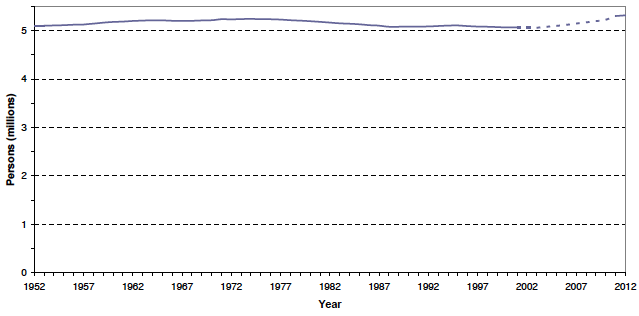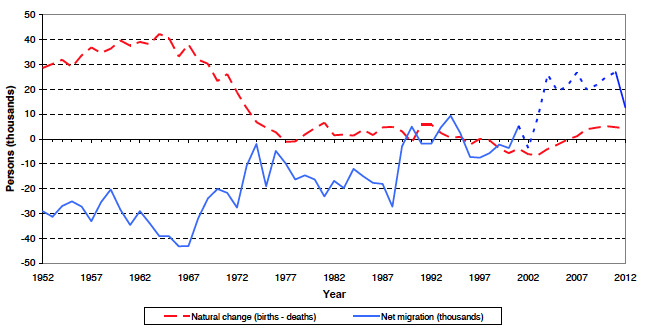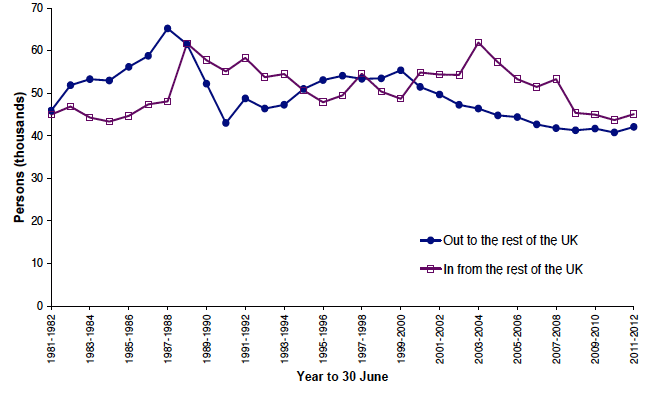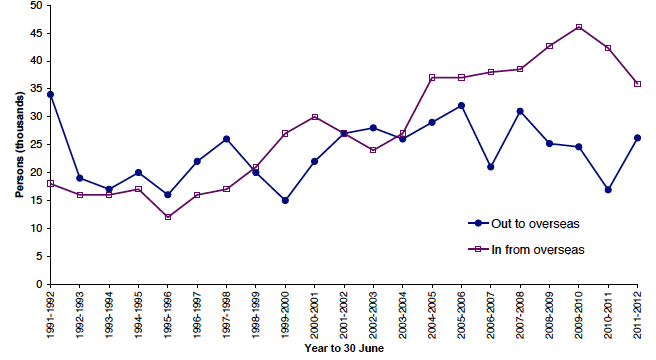
2.1 The latest estimate of Scotland's population (on 30 June 2012) is 5,313,600 - the highest ever and an increase of 18,200 people since Census Day 2011 (Figure 1).
2.2 The recent increase in Scotland's population has been driven mostly by in-migration although, in the last six years, there have also been more births than deaths. In the fifteen months to mid-2012, in-migration exceeded out-migration by 15,200 people. This included a net gain of around 900 people from the rest of the UK and a net gain of around 14,300 from overseas. The net gain of 900 from the rest of the UK in the 15 month period was lower than recent annual figures due to the timing of students leaving Scotland at the end of their courses between Census Day and mid-year 2011. There has not been much change in the net gain to Scotland from the rest of the UK in the last two full year periods at 2,900 and 3,000 respectively. Between Census Day and mid-2012, 43,400 people came to Scotland from overseas and 29,100 left Scotland to go overseas. The net gain of 14,300 represents about 1 in 300 (0.3 per cent) of the total population. Fewer people came to Scotland from overseas in the year to mid-2012, a net gain of 9,700 compared with 25,400 in the previous year. Other changes between Census Day and mid-2012 (including changes in the prison population, and changes in the number of armed forces stationed in Scotland) amounted to a decrease of 3,000 people. The number of births in the fifteen months up to mid-2012 exceeded the number of deaths by 6,000.
Figure 1: Estimated population of Scotland, 1952 to 20121

Footnote
1) Continuous line shows final population estimates and the broken line (2002 to 2010) shows those years which will be rebased using the 2011 Census. Previous years were rebased using the previous censuses.
2.3 Between Census Day 2011 and mid-2012 around 55,600 people came to Scotland from England, Wales and Northern Ireland, and around 54,700 left Scotland to go in the opposite direction. This movement resulted in a net gain of 900 people.
2.4 The overseas net gain of 14,300 came from an inflow of 43,400 and an outflow of 29,100. Estimating international migration is particularly difficult. The estimate is based primarily on the International Passenger Survey (IPS) which is a sample survey conducted at main airports and ports across the UK. The sample size for Scotland is very small (around 300 contacts between Census Day and mid-2012). Internationally, a migrant is defined as someone who changes country of usual residence for 12 months or more, so a short-term seasonal migrant worker will not be counted in the migration estimates or in the mid-year population estimates. More information about the migration data sources and definitions used can be found in Section 6.
2.5 Figure 2 shows the trends in natural change (births minus deaths) and migration. Between the mid-1960s and mid-1970s, both natural change and net out-migration fell dramatically, although the natural increase generally remained greater than the net out-migration. This resulted in growth of population up to 1974. From that point on, through the late 1970s and the 1980s, net out-migration was greater than the natural increase, causing the population to decline. In recent years, Scotland has experienced record levels of net in-migration resulting in small increases in the population in each of the last ten years.
Figure 2: Natural change and net migration1, 1952 to 2012

Footnote
1) The continuous line for net migration represents final estimates. The broken line from 2002 to 2011 shows estimates which may be recalculated as part of rebasing population estimates using information from the 2011 Census.
2.6 Table 7a shows movements to and from the UK and overseas between Census Day 2011 and mid-2012 by age group. The main source of data for the overseas migration calculations is the International Passenger Survey but, because of its small sample size, an age and sex distribution is estimated using various sources including General Medical Practitioner (GP) registrations. The method used to estimate international migration, including improvements made to the methodology is described in Section 6.
2.7 Migrants to Scotland tend to be younger than the general population, as Table 7c shows. Of in-migrants to Scotland, 49 per cent from the rest of the UK and 71 per cent of those from overseas were aged 16-34 years, yet in the resident population only 25 per cent were in this age group. Only five per cent of people coming to Scotland from the rest of the UK and one per cent of people entering from overseas were aged 65 and over. Scotland had a net gain of UK migrants in every age group, except those aged 25-34 and 75-84, and a net gain of international migrants for all ages under 45.
2.8 Figure 3 illustrates the trend in flows of people to and from the rest of the UK since 1981. There has been a slight increase in people coming to Scotland from the rest of the UK to 45,100 following small drops in the previous three years, the recent peak of 61,900 was recorded in 2003-04. There was also a small increase in outward migration to 42,100 in 2011-12 from previous year's figure of 40,800.
Figure 3: Movements to/from the rest of the UK, 1981 to 2012

2.9 Flows of people to and from overseas since 1991 are shown in Figure 4. In- migration from overseas has been increasing since 2003 but has dropped in the last two years with a larger decrease recorded in 2011-12. Out-migration to overseas has risen in 2011-12 following drops estimated in three consecutive years from 2008-09. The figures shown here are from the Long-Term International Migration (LTIM) series produced by the Office of National Statistics (ONS).
Figure 4: Movements to/from overseas, 1991 to 2012

Source: Office for National Statistics Long-Term International Migration.